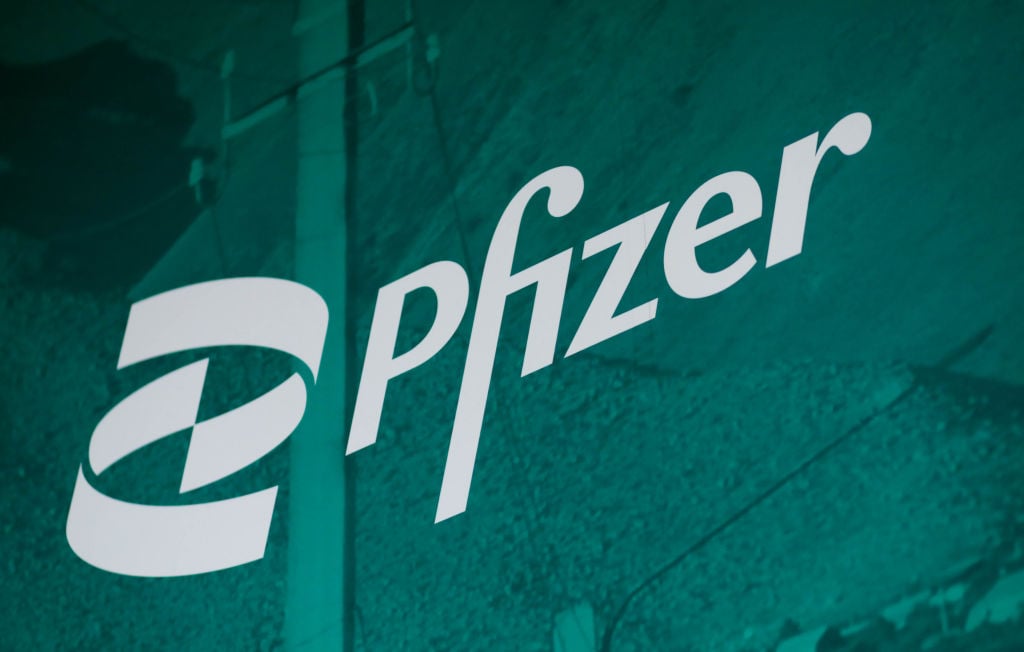If you invest in the Dogs of the Dow every year, you could end up buying Pfizer (PFE 0.10%) on Jan. 1. The strategy calls for buying the top 10 highest dividend-yielding stocks in the Dow Jones Industrial Average, and as of Dec. 18, Pfizer has the sixth highest dividend yield in the Dow. Pfizer's chances of being a winning member of the Dogs of the Dow in 2018 may have improved this week, following its decision to increase its quarterly dividend by 6.3% to $0.34 per share and to add $10 billion more to the $6.4 billion remaining on its share buyback program.

Image source: Getty Images.
What are the Dogs of the Dow?
Dow Jones Industrials includes 30 big-cap blue chip companies, and historically, buying the 10 highest dividend-yielding of these companies at year's end has resulted in market-beating returns.
The strategy calls for investing an equal amount of money into each of the 10 stocks and owning them throughout the entire year, without any turnover until the next Dogs of the Dow are bought.
The Dogs of the Dow strategy doesn't outperform the Dow Jones Industrial Average all the time, but heading into this year, it has outperformed the broader average in six years out of the most recent seven years. In 2017, the Dogs of the Dow is likely to underperform, in large part because of lackluster returns for General Electric (GE 3.62%).
Growing again
Pfizer's sales have fallen significantly in the wake of losing patent protection on Lipitor in 2011, but the company finally appears to be turning an important corner. While Lipitor's sales are still sliding, they're declining from a much lower level, and as a result Pfizer's fast-growing drugs are offsetting those declines and helping revenue tick higher.
For example, Ibrance, Eliquis, and Xeljanz are all posting meaningful revenue growth that supports the company's financials.
Ibrance is an inhibitor of CDK 4/6, a gene that supports cancer growth, and after delivering sales of $2.1 billion in 2016, it's selling at an annualized pace of $3.5 billion in 2017. Sales are growing fastest overseas, but U.S. sales are no slouch, either. Ibrance's U.S. sales were $713 million in third quarter 2017, up 34% from one year ago.
Eliquis, an anticoagulant that Pfizer codeveloped with Bristol-Myers Squibb (NYSE: BMY), has been increasingly stealing away market share from warfarin in atrial fibrillation patients, hip or knee replacement patients, and patients at risk of deep vein thrombosis and pulmonary embolism. Eliquis revenue grew 50% in 2016, and exiting Q3, Eliquis sales were clocking in at an annualized $2.6 billion, up 43% year over year.
Finally, Xeljanz is also moving the needle for the company. Growing use of it by rheumatoid arthritis patients translated into $348 million in third-quarter sales, up from $235 million in the same quarter of 2016.
PFE Revenue (TTM) data by YCharts.
What's next for this company
We'll have to wait until Dec. 31 to see if Pfizer still qualifies to be a Dog of the Dow stock to own in 2018, but if it makes the cut, there's plenty of reasons to think its shares will go higher next year.
First, the company is expected to report full-year 2017 results in February 2018, and based on guidance, that report could show the company is continuing to make headway toward becoming a growth stock again. In November, Pfizer guided for 2017 revenue of between $52.4 billion and $53.1 billion, and adjusted EPS of at least $2.58.
Ibrance, Eliquis, and Xeljanz success will undoubtedly remain important catalysts for growth in 2018, but there are other drugs in Pfizer's pipeline that could make this stock a winning Dog of the Dow in 2018, too. It has 18 oncology drugs in clinical-stage studies, and it expects to initiate three to four pivotal studies over the next few years. That level of activity bodes well for a steady stream of market-moving news.
Overall, improving financials and tailwinds associated with a bigger dividend payment and buyback authorization has me thinking that this potential Dog of the Dow belongs in every investor's portfolio.









